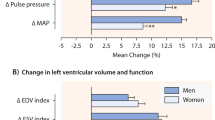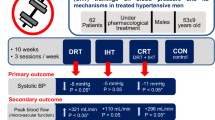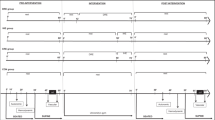Abstract
Exaggerated pressor and muscle sympathetic nerve activity (MSNA) responses have been reported during static handgrip in hypertensive (HTN) adults. Recent work suggests that such responses may occur much more rapidly in HTN patients; however, this has not been extensively studied. Thus, we examined the blood pressure (BP) and MSNA responses at the immediate onset of muscle contraction and tested the hypothesis that older HTN adults would exhibit rapid onset pressor and sympathetic responses compared with normotensive (NTN) adults. Heart rate (HR), BP (Finometer) and MSNA (peroneal microneurography) were retrospectively analyzed in 15 HTN (62±1 years; resting BP 153±3/91±5 mm Hg) and 23 age-matched NTN (60±1 years; resting BP 112±1/67±2 mm Hg) subjects during the first 30 s of static handgrip at 30 and 40% of maximal voluntary contraction (MVC). HTN adults demonstrated exaggerated increases in mean BP during the first 10 s of both 30% (NTN: Δ1±1 vs HTN: Δ7±2 mm Hg; P<0.05) and 40% (NTN: Δ2±1 vs HTN: Δ8±2 mm Hg; P<0.05) intensity handgrip. Likewise, HTN adults exhibited atypical increases in MSNA within 10 s. Increases in HR were also greater in HTN adults at 10 s of 30% MVC handgrip, although not at 40% MVC. There were no group differences in 10 s pressor or sympathetic responses to a cold pressor test, suggesting no differences in generalized sympathetic responsiveness. Thus, static handgrip evokes rapid onset pressor and sympathetic responses in older HTN adults. These findings suggest that older HTN adults likely have greater cardiovascular risk even during short duration activities of daily living that contain an isometric component.
This is a preview of subscription content, access via your institution
Access options
Subscribe to this journal
Receive 12 digital issues and online access to articles
$119.00 per year
only $9.92 per issue
Buy this article
- Purchase on Springer Link
- Instant access to full article PDF
Prices may be subject to local taxes which are calculated during checkout



Similar content being viewed by others
References
Aoki K, Sato K, Kondo S, Pyon CB, Yamamoto M . Increased response of blood pressure to rest and handgrip in subjects with essential hypertension. Jpn Circ J 1983; 47 (7): 802–809.
Hamada M, Kazatani Y, Shigematsu Y, Ito T, Kokubu T, Ishise S . Enhanced blood pressure response to isometric handgrip exercise in patients with essential hypertension: effects of propranolol and prazosin. J Hypertens 1987; 5 (3): 305–309.
Kazatani Y, Hamada M, Shigematsu Y, Hiwada K, Kokubu T . Beneficial effect of a long-term antihypertensive therapy on blood pressure response to isometric handgrip exercise in patients with essential hypertension. Am J Therap 1995; 2 (3): 165–169.
Matthews CE, Pate RR, Jackson KL, Ward DS, Macera CA, Kohl HW et al. Exaggerated blood pressure response to dynamic exercise and risk of future hypertension. J Clin Epidemiol 1998; 51 (1): 29–35.
Hoberg E, Schuler G, Kunze B, Obermoser AL, Hauer K, Mautner HP et al. Silent myocardial ischemia as a potential link between lack of premonitoring symptoms and increased risk of cardiac arrest during physical stress. Am J Cardiol 1990; 65 (9): 583–589.
Kokkinos PF, Andreas PE, Coutoulakis E, Colleran JA, Narayan P, Dotson CO et al. Determinants of exercise blood pressure response in normotensive and hypertensive women: role of cardiorespiratory fitness. J Cardiopulm Rehab 2002; 22 (3): 178–183.
Mittleman MA, Maclure M, Tofler GH, Sherwood JB, Goldberg RJ, Muller JE . Triggering of acute myocardial infarction by heavy physical exertion. Protection against triggering by regular exertion. Determinants of Myocardial Infarction Onset Study Investigators. N Engl J Med 1993; 329 (23): 1677–1683.
Mittleman MA, Siscovick DS . Physical exertion as a trigger of myocardial infarction and sudden cardiac death. Cardiol Clin 1996; 14 (2): 263–270.
American College of Sports Medicine Position Stand. The recommended quantity and quality of exercise for developing and maintaining cardiorespiratory and muscular fitness, and flexibility in healthy adults. Med Sci Sports Exerc 1998; 30 (6): 975–991.
Fletcher GF, Balady G, Froelicher VF, Hartley LH, Haskell WL, Pollock ML . Exercise standards. A statement for healthcare professionals from the American Heart Association. Writing Group. Circulation 1995; 91 (2): 580–615.
Pate RR, Pratt M, Blair SN, Haskell WL, Macera CA, Bouchard C et al. Physical activity and public health. A recommendation from the Centers for Disease Control and Prevention and the American College of Sports Medicine. JAMA 1995; 273 (5): 402–407.
Coote JH, Hilton SM, Perez-Gonzalez JF . The reflex nature of the pressor response to muscular exercise. J Physiol 1971; 215 (3): 789–804.
Goodwin GM, McCloskey DI, Mitchell JH . Cardiovascular and respiratory responses to changes in central command during isometric exercise at constant muscle tension. J Physiol 1972; 226 (1): 173–190.
Kaufman MP, Longhurst JC, Rybicki KJ, Wallach JH, Mitchell JH . Effects of static muscular contraction on impulse activity of groups III and IV afferents in cats. J Appl Physiol 1983; 55 (1, Part 1): 105–112.
Delaney EP, Greaney JL, Edwards DG, Rose WC, Fadel PJ, Farquhar WB . Exaggerated sympathetic and pressor responses to handgrip exercise in older hypertensive humans: role of the muscle metaboreflex. Am J Physiol Heart Circ Physiol 2010; 299 (5): H1318–H1327.
Greaney JL, Matthews EL, Boggs ME, Edwards DG, Duncan RL, Farquhar WB . Exaggerated exercise pressor reflex in adults with moderately elevated systolic blood pressure: role of purinergic receptors. Am J Physiol Heart Circ Physiol 2014; 306 (1): H132–H141.
Sausen MT, Delaney EP, Stillabower ME, Farquhar WB . Enhanced metaboreflex sensitivity in hypertensive humans. Eur J Appl Physiol 2009; 105 (3): 351–356.
Leal AK, Murphy MN, Iwamoto GA, Mitchell JH, Smith SA . A role for nitric oxide within the nucleus tractus solitarii in the development of muscle mechanoreflex dysfunction in hypertension. Exp Physiol 2012; 97 (12): 1292–1304.
Leal AK, Williams MA, Garry MG, Mitchell JH, Smith SA . Evidence for functional alterations in the skeletal muscle mechanoreflex and metaboreflex in hypertensive rats. Am J Physiol Heart Circ Physiol 2008; 295 (4): H1429–H1438.
Mizuno M, Murphy MN, Mitchell JH, Smith SA . Skeletal muscle reflex-mediated changes in sympathetic nerve activity are abnormal in spontaneously hypertensive rats. Am J Physiol Heart Circ Physiol 2011; 300 (3): H968–H977.
Murphy MN, Mizuno M, Mitchell JH, Smith SA . Cardiovascular regulation by skeletal muscle reflexes in health and disease. Am J Physiol Heart Circ Physiol 2011; 301 (4): H1191–H1204.
Smith SA, Williams MA, Leal AK, Mitchell JH, Garry MG . Exercise pressor reflex function is altered in spontaneously hypertensive rats. J Physiol 2006; 577 (Pt 3): 1009–1020.
Vongpatanasin W, Wang Z, Arbique D, Arbique G, Adams-Huet B, Mitchell JH et al. Functional sympatholysis is impaired in hypertensive humans. J Physiol 2011; 589 (Part 5): 1209–1220.
Williamson JW, Nobrega AC, Winchester PK, Zim S, Mitchell JH . Instantaneous heart rate increase with dynamic exercise: central command and muscle–heart reflex contributions. J Appl Physiol (1985) 1995; 78 (4): 1273–1279.
Eguchi K, Hoshide S, Schwartz JE, Shimada K, Kario K . Visit-to-visit and ambulatory blood pressure variability as predictors of incident cardiovascular events in patients with hypertension. Am J Hypertens 2012; 25 (9): 962–968.
Parati G, Ochoa JE, Bilo G . Blood pressure variability, cardiovascular risk, and risk for renal disease progression. Curr Hypertens Rep 2012; 14 (5): 421–431.
Pickering TG, Hall JE, Appel LJ, Falkner BE, Graves J, Hill MN et al. Recommendations for blood pressure measurement in humans and experimental animals: part 1: blood pressure measurement in humans: a statement for professionals from the Subcommittee of Professional and Public Education of the American Heart Association Council on High Blood Pressure Research. Circulation 2005; 111 (5): 697–716.
Chobanian AV, Bakris GL, Black HR, Cushman WC, Green LA, Izzo JL Jr, et al. Seventh report of the Joint National Committee on Prevention, Detection, Evaluation, and Treatment of High Blood Pressure. Hypertension 2003; 42 (6): 1206–1252.
Sundlof G, Wallin BG . Human muscle nerve sympathetic activity at rest. Relationship to blood pressure and age. J Physiol 1978; 274: 621–637.
Victor RG, Leimbach WN Jr ., Seals DR, Wallin BG, Mark AL . Effects of the cold pressor test on muscle sympathetic nerve activity in humans. Hypertension 1987; 9 (5): 429–436.
Greaney JL, Ray CA, Prettyman AV, Edwards DG, Farquhar WB . Influence of increased plasma osmolality on sympathetic outflow during apnea. Am J Physiol Regul Integr Compar Physiol 2010; 299 (4): R1091–R1096.
Hamner JW, Taylor JA . Automated quantification of sympathetic beat-by-beat activity, independent of signal quality. J Appl Physiol (1985) 2001; 91 (3): 1199–1206.
Cui J, Blaha C, Moradkhan R, Gray KS, Sinoway LI . Muscle sympathetic nerve activity responses to dynamic passive muscle stretch in humans. J Physiol 2006; 576 (Part 2): 625–634.
Keller DM, Fadel PJ, Ogoh S, Brothers RM, Hawkins M, Olivencia-Yurvati A et al. Carotid baroreflex control of leg vasculature in exercising and non-exercising skeletal muscle in humans. J Physiol 2004; 561 (Part 1): 283–293.
Muenter Swift N, Cutler MJ, Fadel PJ, Wasmund WL, Ogoh S, Keller DM et al. Carotid baroreflex function during and following voluntary apnea in humans. Am J Physiol Heart Circ Physiol 2003; 285 (6): H2411–H2419.
Mark AL, Victor RG, Nerhed C, Wallin BG . Microneurographic studies of the mechanisms of sympathetic nerve responses to static exercise in humans. Circ Res 1985; 57 (3): 461–469.
Lalande S, Sawicki CP, Baker JR, Shoemaker JK . Effect of age on the hemodynamic and sympathetic responses at the onset of isometric handgrip exercise. J Appl Physiol (1985) 2014; 116 (2): 222–227.
Muller MD, Drew RC, Blaha CA, Mast JL, Cui J, Reed AB et al. Oxidative stress contributes to the augmented exercise pressor reflex in peripheral arterial disease patients. J Physiol 2012; 590 (Part 23): 6237–6246.
Greaney JL, Farquhar WB . Skeletal muscle contraction triggers rapid onset pressor responses in cardiovascular disease. J Physiol 2012; 590 (Part 23): 5933–5934.
Smith SA, Mitchell JH, Naseem RH, Garry MG . Mechanoreflex mediates the exaggerated exercise pressor reflex in heart failure. Circulation 2005; 112 (15): 2293–2300.
Middlekauff HR, Chiu J, Hamilton MA, Fonarow GC, Maclellan WR, Hage A et al. Muscle mechanoreceptor sensitivity in heart failure. Am J Physiol Heart Circ Physiol 2004; 287 (5): H1937–H1943.
Middlekauff HR, Nitzsche EU, Hoh CK, Hamilton MA, Fonarow GC, Hage A et al. Exaggerated muscle mechanoreflex control of reflex renal vasoconstriction in heart failure. J Appl Physiol (1985) 2001; 90 (5): 1714–1719.
Momen A, Bower D, Boehmer J, Kunselman AR, Leuenberger UA, Sinoway LI . Renal blood flow in heart failure patients during exercise. Am J Physiol Heart Circ Physiol 2004; 287 (6): H2834–H2839.
Potts JT, Shi XR, Raven PB . Carotid baroreflex responsiveness during dynamic exercise in humans. Am J Physiol 1993; 265 (6, Part 2): H1928–H1938.
Gallagher KM, Fadel PJ, Stromstad M, Ide K, Smith SA, Querry RG et al. Effects of partial neuromuscular blockade on carotid baroreflex function during exercise in humans. J Physiol 2001; 533 (Part 3): 861–870.
Querry RG, Smith SA, Stromstad M, Ide K, Raven PB, Secher NH . Neural blockade during exercise augments central command's contribution to carotid baroreflex resetting. Am J Phys Heart Circ Physiol 2001; 280 (4): H1635–H1644.
al-Ani M, Robins K, al-Khalidi AH, Vaile J, Townend J, Coote JH . Isometric contraction of arm flexor muscles as a method of evaluating cardiac vagal tone in man. Clin Sci (Lond) 1997; 92 (2): 175–180.
Bull RK, Davies CT, Lind AR, White MJ . The human pressor response during and following voluntary and evoked isometric contraction with occluded local blood supply. J Physiol 1989; 411: 63–70.
Gladwell VF, Coote JH . Heart rate at the onset of muscle contraction and during passive muscle stretch in humans: a role for mechanoreceptors. J Physiol 2002; 540 (Part 3): 1095–1102.
Flaa A, Mundal HH, Eide I, Kjeldsen S, Rostrup M . Sympathetic activity and cardiovascular risk factors in young men in the low, normal, and high blood pressure ranges. Hypertension 2006; 47 (3): 396–402.
Carthy ER, White L, Russell FD, Holmes M, Leicht AS, Brooks PR et al. Cardiovascular responsiveness to sympathoexcitatory stress in subjects with and without mild hypertension. Clin Physiol Funct Imag, (e-pub ahead of print 1 April 2014; doi:10.1111/cpf.12143).
Victor RG, Bertocci LA, Pryor SL, Nunnally RL . Sympathetic nerve discharge is coupled to muscle cell pH during exercise in humans. J Clin Invest 1988; 82 (4): 1301–1305.
Victor RG, Seals DR, Mark AL . Differential control of heart rate and sympathetic nerve activity during dynamic exercise. Insight from intraneural recordings in humans. J Clin Invest 1987; 79 (2): 508–516.
Acknowledgements
The time and effort expended by all the volunteer subjects are greatly appreciated. We acknowledge the assistance of Dr Erin E Paul with data collection. We also thank Dr Allen Prettyman and Dr Michael Stillabower for assistance with medical screening of participants. The support of Kathy Masso, BS is appreciated. This research was supported by an American College of Sports Medicine Foundation Grant (to JLG). JLG was supported by an American Heart Association Predoctoral Fellowship (11PRE7580026).
Author Contributions
JLG, DGE, PJF and WBF: conception and design of research; JLG and WBF: performed experiments; JLG: analyzed the data; JLG, DGE, PJF and WBF: interpreted results of experiments; JLG: prepared figures and drafted the manuscript; JLG, DGE, PJF and WBF: edited and revised the manuscript; and JLG, DGE, PJF and WBF: approved the final version of the manuscript. The experiments of this study were conducted in the Departments of Kinesiology and Applied Physiology and Biological Sciences at the University of Delaware, Newark, DE, USA.
Author information
Authors and Affiliations
Corresponding author
Ethics declarations
Competing interests
The authors declare no conflict of interest.
Rights and permissions
About this article
Cite this article
Greaney, J., Edwards, D., Fadel, P. et al. Rapid onset pressor and sympathetic responses to static handgrip in older hypertensive adults. J Hum Hypertens 29, 402–408 (2015). https://doi.org/10.1038/jhh.2014.106
Received:
Revised:
Accepted:
Published:
Issue Date:
DOI: https://doi.org/10.1038/jhh.2014.106
This article is cited by
-
Sex differences in insular cortex gyri responses to a brief static handgrip challenge
Biology of Sex Differences (2017)



